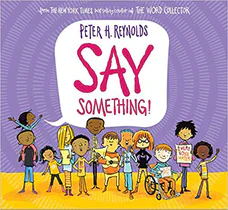Say Something

Recommended Age Range: Preschool through 3rd grade.
Publisher's Summary:
The world needs your voice. If you have a brilliant idea . . . say something! If you see an injustice . . . say something!…Perfect for budding activists everywhere, this timely story reminds readers of the undeniable importance and power of their voice. There are so many ways to tell the world who you are . . . what you are thinking . . . and what you believe. And how you’ll make it better. The time is now: SAY SOMETHING!

Dr. Annie's Takeaways
Recommended for: This book encourages children to share their ideas and to make a difference with their voices, actions, and art. It’s a great start to talking about what children can do about injustices they see or problems they care about (e.g., racism, climate change, bullying at school). This book explicitly states right at the beginning that children can say something in any way that fits for them. “You don’t have to be loud. Powerful words can be a whisper. You can say something in so many ways. With words, with action, with creativity.”
Would a child like it? Most children will love this book’s reminder that their ideas and contributions to the world matter. It’s energizing and lifts children up.
Tone: Empowering, uplifting
Story Quality: This book is a celebration of children’s contribution to the world. It is written simply and effectively, with relatively few words per page. It is written in second person, which makes it feel as if the author is speaking directly to the child reading the book. The text of the book largely follows a format of “If_____, say something to/by _________.” Some examples include: “If you are angry, say something to help people understand.” “If you want to show the world who you are, say something with style.” “If you see someone lonely, say something by just being there for them.”
Illustrations: Charming, expressive illustrations with a great use of color.
Representation: Many different children are represented in the illustrations, including children with different genders, races, and ethnicities. There is a boy who uses a wheelchair pictured in one illustration. A Black girl is featured at the beginning and ending of the story.
Psychological Practices: This story broadens the definition of what it means to “say something” by encouraging children to “speak” in whatever ways fit for them: quietly, loudly, through art, through actions, through peaceful protests, and by sharing their feelings with a friend. It tells children that the “world needs your voice” and that a child’s voice can “inspire, heal, and transform.” Empowering children to speak up about what matters to them is a wonderful way to counteract feelings of hopelessness and frustration that children (and adults) often experience when witnessing something that goes against their values or sense of justice.
Concerns: None.
